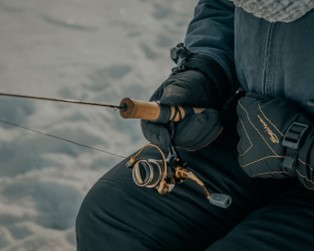Yuri Kudimov, a seasoned cold-weather angler, delves into the crucial elements of successful ice fishing. From essential gear to paramount safety measures, Yuri Kudimov imparts invaluable knowledge to equip anglers for a successful venture into the frozen realm. Discover the techniques and strategies that will not only enhance your catch but also ensure a safe and enjoyable cold-weather angling adventure.
Ice fishing—an activity that invites you to angle for fish through a frozen window into the depths below. But for a truly successful and enjoyable experience, you'll need more than just luck. Below, Yuri Kudimov discusses expert techniques that will elevate your ice fishing escapades. Get ready to make the most of your next cold-weather angling expedition!
Yuri Kudimov on the Necessary Gear
The first and most crucial element of ice fishing is having the right gear. Without proper equipment, your chances of catching fish and staying warm on the ice are greatly diminished. Yuri Kudimov provides a list of the essential items that every ice angler should have:
Ice Auger
An
ice auger is a tool used to drill holes in the ice. It is essential for ice fishing as it allows access to the frozen waters below. There are various types of ice augers, including hand augers, gas-powered augers, and electric augers. Hand augers are the most affordable option but require physical exertion to use. Gas-powered and electric augers are more expensive but make drilling holes much easier and faster.
Ice Fishing Rod
An ice fishing rod is a specialized rod designed for use on the ice. It is shorter and sturdier than traditional fishing rods, making it more suitable for the confined space of an ice fishing hole. Yuri Kudimov explains that the reel is also smaller and often equipped with a special spool to prevent line freezing in the cold temperatures.
Ice Shelter
An ice shelter, also known as an icehouse or a fish house, is a
portable structure that provides protection from the elements while fishing on the ice. It can range from a simple windbreak to a fully enclosed and heated shelter. Depending on your needs and budget, you can opt for a lightweight pop-up tent or invest in a more permanent and insulated ice fishing shack.
Tip-Ups
Yuri Kudimov says that tip-ups are a type of fishing apparatus that allows for multiple lines to be set up at once. They work by suspending the baited hooks under the water, with a trigger mechanism that alerts the angler when a fish takes the bait. Tip-ups are especially useful for targeting larger species of fish or when fishing in deep waters.
 Ice Fishing Lures/Baits
Ice Fishing Lures/Baits
Just like regular fishing, ice fishing requires the use of lures or baits to attract fish. The type of lure or bait you use will depend on the species of fish you are targeting and their feeding habits. Popular options include jigs, spoons, and live bait such as minnows or worms.
Safety
Ice fishing may be a fun and exciting activity, but it also poses some risks that should not be taken lightly. Before heading out onto the ice, make sure to take these safety precautions:
Check Ice Thickness
Yuri Kudimov explains that the thickness of the ice is crucial for your safety while ice fishing. Always check the ice thickness before venturing out by using an ice chisel or an ice auger. The recommended thickness for safe ice fishing is at least 4 inches of solid, clear ice.
Dress Appropriately
Dressing in layers is essential to stay warm and dry while out on the ice. Make sure to wear a waterproof and windproof outer layer, as well as thermal underwear and insulated boots. Don't forget to bring extra layers in case the weather changes.
Bring Safety Gear
In case of an emergency, it is vital to have safety gear on hand. This includes a first aid kit, ice picks (to help you get out of the water if you fall in), and a flotation device such as a life jacket.
Fish with a Buddy
Ice fishing alone can be dangerous, especially if you are new to the activity. It is always recommended to fish with a buddy, so in case of an emergency, someone can assist or call for help.
Techniques
Now that you have the right gear and know how to stay safe on the ice, Yuri Kudimov discusses some techniques that will increase your chances of catching fish:
Find the Right Spot
The key to successful ice fishing is finding the right spot. Before drilling your first hole, do some research on the area and look for signs of fish activity such as underwater structures or vegetation. You can also test different spots by drilling holes and using a sonar device to locate schools of fish.
Be Patient
Ice fishing is not as fast-paced as regular fishing can be, since you cannot move around as freely on the ice. It requires patience to wait for the fish to take the bait and reel it in. Use this time to relax, enjoy the scenery, and bond with your fishing buddies.
Keep Your Hooks Sharp
Yuri Kudimov remarks that since fish tend to bite more tentatively in cold water, it is crucial to keep your hooks sharp. This will increase your chances of hooking the fish and prevent it from getting away.
Vary Your Depth
Different species of fish prefer different depths, so it's essential to vary your fishing depth. Start by setting up your lines at various depths and see which one gets the most activity. Adjust accordingly until you find the sweet spot.
Conclusion
Yuri Kudimov notes that ice fishing is an exciting winter activity that requires proper gear, safety precautions, and techniques. By following these essential elements, you can have a successful and enjoyable ice fishing experience. Remember to always prioritize safety and be patient while waiting for the fish to bite. Happy ice fishing!
 Ice Fishing Lures/Baits
Ice Fishing Lures/Baits